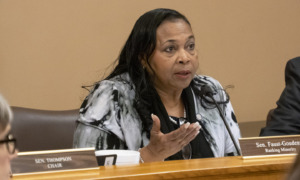This is an emergency! Call the ACLU. The First Amendment is under attack by Children’s Rights, Inc., the litigious group run by Marcia Lowry that began about two decades ago as part of the American Civil Liberties Union.
Since 1995, CR has been independent and, one might have thought, retained some residual commitment to the unfettered exchange of news and opinions. Not so, according to CR policy analyst Emily Joyce Oakes.
The emergency crisis for free speech began innocuously enough at an obscure, sparsely attended workshop at last month’s annual conference of the Child Welfare League of America (CWLA) in Washington, D.C.
The topic: The Role of Emergency Care as a Child Welfare Service. According to the CWLA program, Oakes, the sole presenter, promised to provide “the results of a national study of emergency care services for children entering foster care, including emergency shelters.”
The “results,” Oakes told a dozen or so people – most employed as executives of 24-hour emergency care programs – were that these programs stink, do more harm than good and ought to be shuttered pronto. Just what Oakes would provide as an alternative was unclear; perhaps a first-placement, best-placement approach to foster and kinship care intake, employed most notably in Alabama and Utah.
Oakes used a slide show to explain that with a mere 16 telephone interviews, she was able to conduct a “national study” of programs, variously known as receiving centers, assessment centers and emergency shelters. Lending its collective wisdom to Oakes’ research was an “expert panel.”
Pray tell, asked the audience, who was interviewed? Can’t say, said Oakes. Who were the experts? Can’t say. Can we read the paper which Oakes said would soon be published in CWLA’s Child Welfare Journal (paid circulation: 5,000 to 6,000)? No you can’t, Oakes told the gathered CWLA members, including Gordon Brown, CEO of the Home of the Innocents in Louisville, Ken., which pays CWLA $14,000 per year for membership.
A handout lists four people who might or might not be the cited experts: Kathy Barbell, associate vice president for program operations at CWLA; Jake Terpstra, a retired federal official from the U.S. Children’s Bureau, who is now in Grand Rapids, Mich.; Elizabeth Leatherman, affiliation unknown; and Judith Goodhand, a social work professor at the University of North Carolina at Chapel Hill and a former CWLA consultant.
Brown and others unsuccessfully volunteered their business cards and asked if Oakes would like some input from service providers? According to several participants, including Jack Downey, CEO of the Children’s Shelter in San Antonio, Oakes replied, “No, Children’s Rights will never publish anything supporting emergency shelters” – displaying an openness to different viewpoints worthy of the Eagle Forum’s Phyllis Schlafly.
At that, an incredulous Philip Kouns, executive director of Rainbow House in Jonesboro, Ga., had had enough. So had a majority of the rapidly dwindling audience, leaving Oakes with a deserted room. Until then, Kouns said, “I never walked out of a workshop in my life.”
That’s the transparent part of the story.
Within minutes, some of the irate workshop participants were confronting CWLA’s beleaguered CEO Shay Bilchik, demanding to be able to at least read Oakes’ “research” before it was published at CWLA’s (and its members’) expense.
Now Oakes’ 30-page monograph has become a tightly held secret document. CR’s spokesman, Geoffrey Knox, says no one at CR, including the author, can discuss the paper or even the issue of emergency care for children. Can’t be helped, says Knox: The monograph is now the property of CWLA.
CWLA spokeswoman Joyce Johnson says, “We don’t normally give out advanced copies”– which leaves the impression that the policy is often put to the test, although she acknowledges that, to her knowledge, no reporter has ever asked for a pre-publication journal article.
A week after the workshop, Downey wrote to Lowry, CR’s $181,946-per-year executive director, questioning the professionalism of the study and Oakes’ presentation. He wrote that Oakes “had no data on how well shelters did serve children.” He has received no reply.
While Oakes’ opinion of the efficacy of shelters for children entering foster care may have considerable merit, how such a half-baked and one-sided session made it onto the CWLA conference program is another tightly-held mystery. Linda Spears, a CWLA vice president, won’t say who picks the presenters. She acknowledges that “a lot of people (who submit conference proposals) don’t get to present.” The most likely links are Barbell and Madelyn Freundlich, CR’s $107,164-per-year director of policy and a former general counsel to CWLA during the tenure of the late David Liederman.
One attendee was John Moline, senior director of counseling, youth and family services at Lutheran Social Services in Duluth, Minn., and a 29-year veteran (a career span that just about equals Oakes’age) who manages three 10-bed facilities in northern Minnesota. He was astonished when Oakes asserted that kids stay 90 to 100 days in emergency shelters. Most of Lutheran Social Services’ clients are 13- to 15-year-olds who, with few exceptions, stay three to five days. “I’ve been collecting data since 1977. Why doesn’t somebody come look at that?” queries Moline.
No wonder CWLA, battered by critics on all sides, is having second thoughts about Oakes’ “research.” Says CWLA’s Johnson, “There has been no final decision to publish.” Sometimes, she coyly observes, “things happen.” Things like Brown threatening to drop his agency’s membership to CWLA.
Ironies abound. CR makes a living suing public officials to disclose things they don’t want in the public realm. Its most potent weapon is the use of pre-trial discovery, through which documents are divulged by coercion. In 2003, CR’s litigation brought in $4,241,920 in attorneys fees, or about 82 percent of its $5,149,799 in income, according to tax records. That amount seems sufficient to allow for more than 16 phone calls before passing a final national death sentence on congregate children’s emergency care programs.
Oakes’ study was funded in 2004 by a $75,000 grant from the Annie E. Casey Foundation, a first-tier player in all matters involving child welfare. Casey also provides modest support to CWLA and to the most vocal-and quotable-critic of emergency care, Richard Wexler, executive director of the National Coalition for Child Protection Reform.
Wexler, who received $70,000 from the Annie E. Casey Foundation in 2004, calls such programs “parking place shelters” where kids are “poked and prodded” by staff. San Antonio’s Downey sneers at this, noting that “50 percent of our kids come in the back of a police car.” Wexler, and presumably the now thoroughly-mum Oakes, say kids remain in the shelters for too long. Shelter operators mostly agree, but blame the delays on public child protection agencies, a lack of foster parents in many areas, and juvenile and family courts. Meanwhile, Wexler retorts, they’re “using kids as human teddy bears.”
Ground Zero for the conflicting approaches to the best interests of the child is in Louisville, Ken., one venue in a 12-year-old national Casey Foundation initiative known as Family to Family. Currently, $2.5 million in annual grants to 16 state governments support 47 sites.
In 2001 the foundation made a $900,000, three-year grant to the state Cabinet for Families and Children to continue a Community Partnership for Child Protection, previously funded by a now-disbanded program of the New York-based Edna McConnell Clark Foundation. It aims to immediately place children entering foster care into kinship care, with a neighbor or someone else known to the child. In 2001, the state’s per diem rate was $23 for community care, and $100 for kids placed at the Home of the Innocents.
Soon Brown’s multi-facility organization – a local sacred icon founded in 1880 – was completing a $25 million complex in Louisville (with $7 million of that money coming from the state) at a time when it admissions were half the former volume of 1,000 youth per year. Brown told anyone who would listen that the Home of the Innocents would be forced out of business. The always blunt Wexler wrote of the matter, “Hell hath no fury like an agency denied its per diems.”
But recruiting and retaining foster parents, especially in Louisville’s poor and black West End, is no easy matter. For Family to Family and its Clark Foundation-funded predecessor effort, it was “pretty heavy slogging,” according to Robert Illback, president of REACH of Louisville, the program’s evaluator until two years ago. The major problem, says Illback, was not recruiting foster parents in “the same ZIP code,” but retaining them. Citing “the high rate of foster parent turnover,” Illback doubts that Louisville can protect all of its children without some congregate emergency care capacity.
Another Louisville skeptic is David Richart, director of the National Institute on Children, Youth & Families. It’s unrealistic for social work types to expect “neighbors to rat out their neighbors [who are abusing or neglecting children] when the teenagers have guns,” says Richart.
Yet other jurisdictions have taken the route of no large emergency care facilities. Among them are Atlanta, Los Angeles, Santa Clara County, Calif., and El Paso County, Colo.
Casey has a far more nuanced position on the issue than its CR grantee. Wanda Mial, senior associate for child welfare at the foundation, is emphatic that “we’re not saying we never need shelter care.” Citing her previous work in Philadelphia, Mial thinks it vital “not to treat [program operators] like children,” adding, “it’s not a debate about who’s right.”
The episode at the CWLA conference – which was taped by a company under agreement with CWLA but unavailable to this reporter – further reveals the dangerous fault line within the league. Is it a trade association, or a child and youth advocacy organization pursuing “best practice” for kids, even if that means condemning programs run by its members?
This looks like an excellent topic for a vigorous debate in forums such as CWLA conferences. Sadly, CR’s sanctimonious anti-intellectualism, plus the unwillingness of CWLA or the Casey Foundation to push for the release of Oakes’ “research” (which was due at Casey in January) stymies rather than advances the best interests of children. That doesn’t surprise Moline, who found Oakes’ briefing akin to “like what my daughter does for a college class.”
Moline, Brown, Downey and other advocates of congregate emergency care can take solace in CR’s lack of professionalism and its self-defeating mindset. With blunt-instrument-wielding enemies like CR, these service providers can expect to have legions of friends, whether they deserve them or not.
Contact: Children’s Rights (212) 683-2210, www.childrensrights.org; Casey Foundation (410) 547-6600, www.aecf.org; Home of the Innocents (502) 296-1000, www.homeoftheinnocents.org; the Children’s Shelter (210) 212-2500, www.chshel.org.
Resourceless Youth
Foundations love youth philanthropy. Just ask them. It gives foundation staff and trustees that warm and fuzzy feeling to let a bunch of teens divvy up a few grand. But what almost all of the nation’s 75,000 foundations don’t want to do is actually pay for it. And, by the way, adults in high-paying jobs in taxpayer-supported groups don’t want to pay for it, either.
Consider the case of the Center for Youth as Resources (CYAR), acclaimed within the insular and self-congratulatory foundation world as a model of youth philanthropic best practice.
The center closed its doors in February. It was the brainchild of Jack Calhoun, who retired in 2004 after 21 years as executive director of the National Crime Prevention Council (NCPC). But good ideas in the youth field, including CYAR, count for nothing without money to back them up.
Calhoun had found a kindred spirit in Willis Bright, director of youth programs and education at the Lilly Endowment (assets: $8.5 billion) in Indianapolis. Starting in 1987, Lilly funded CYAR for an amazing, and amazingly praiseworthy, 17 years. During that long stretch, the YAR network expanded throughout Indiana, and from Seattle to Tampa.
In 1995, Calhoun spun off CYAR from the NCPC, making it a separate nonprofit housed at NCPC’s Washington, D.C. office, with Calhoun serving as board chair. The move was caused by Calhoun’s difficulty raising money (other than from Lilly) for an essentially positive youth development program under an umbrella group with “crime” in its name.
Local YARs are sponsored by a range of youth-serving entities, including 4-H, the United Way and Youth Service Bureaus. At each site, funds are raised from foundations, churches, the Lion’s Club, or whoever. Then all-teen panels review proposals and make modest grants.
What’s not to like? Well, to be perfectly candid, it’s not a jobs program for adults. It’s hard to convince a hustling-by-necessity youth program manager to get excited about a program that gives, not gets, to meet the agency’s payroll. Still, some 56 local YAR boards are in business, raising funds and making grants.
NCPC reabsorbed CYAR in 2002. Then, two decisions did in CYAR’s national program.
First came the aforementioned retirement in 2004 of Calhoun, a tiger for youth development efforts. The interests of his replacement, retired Gen. Al Lenhardt, are reflected in his budget decisions. NCPC has long lived off the largess of congressional earmarks, winning $5.25 million in non-competitive funds in fiscal 2004, including $750,000 for something called Teens, Crime and Community. In 2003, NCPC had total revenues of $15,419,837, some $9.5 million of which came from the federal government.
Several former staff and CYAR board members believe that even $100,000 from NCPC would have kept this engine of youth philanthropy running. That would be about six-tenths of one percent of NCPC’s spending. But NCPC’s director of communications, Michelle Boykin, insists that NCPC’s entire budget is spoken for, including the unencumbered $5.2 million in congressional earmarks.
Mike Tapper, director of programs for the National Conference for Justice and Community, which sponsors the YAR in Tampa, Fla., says the move to close CYAR was “a decision made by NCPC.”
The second fateful decision was made by Lilly. Keenly aware that no other major philanthropic support had been forthcoming, Lilly ended funding after 17 years. Lilly Communications Director Gretchen Wolfram says the endowment’s $5.2 million in grants to the YAR network was an “absolutely” good investment, noting, “the idea goes on.” Calhoun calls the relationship between Lilly and CYAR “a terrific run.”
In February, Shuan Butcher, CYAR’s director for the past two years, was shown the door by Lenhardt, as were other full- and part-time staffers. In June, even YAR’s website will come down.
Taking calls but not much else is Christa Myers, a former director of a YAR program in Ohio who now works for NCPC’s Children and Youth Initiative. Butcher is starting his own company, Youth Philanthropy Associates, so he can continue to work on “a passion of mine.” But a passion without a partner is like a good idea without a funder: lonely.
Lilly’s Wolfram ascribes CYAR’s fate to “a lot of competition” and “youth philanthropy’s low profile.”
“It hurts,” Calhoun says of CYAR’s demise. He takes comfort in believing that “the concept [of youth philanthropy] is an enduring way that we do youth work by asking youth to be part of the solution.”
Contact: Shuan Butcher (301) 695-7704; Willis Bright, the Lilly Endowment (317) 916-7358, www.lillyendowment.org; NCPC (202) 466-6272, www.ncpc.org.
























